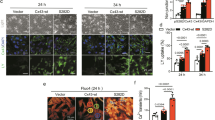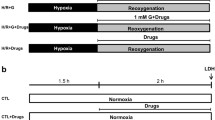Abstract
The mammalian Na+/H+ exchanger isoform 1 (NHE1) is a ubiquitously expressed membrane protein that regulates intracellular pH in the myocardium and other tissues. NHE1 is an important mediator of myocardial damage that occurs after ischemia–reperfusion injury. It has also been implicated in apoptotic damage in many tissues and its expression and activity are elevated in disease states in the myocardium. In this study, we examined the effect of additional exogenous NHE1 expression on isolated cardiomyocytes susceptibility to ischemia/reperfusion damage. Exogenous NHE1 elevated Na+/H+ exchanger expression and activity when introduced into isolated cardiomyocytes through an adenoviral system. Isolated cardiomyocytes were subjected to simulated ischemia and reperfusion after infection with either control or NHE1-containing adenovirus. Cells were placed into an anaerobic chamber and effects of NHE1 expression after hypoxia/reoxygenation were examined. Hypoxia/reoxygenation increased caspase-3-like activity in controls, and the effect was greatly magnified in cells expressing NHE1 protein. It also elevated the percentage of apoptotic cardiomyocytes, which was also aggravated by expression of NHE1 protein. Hypoxia/reoxygenation also increased phospho-ERK levels. Elevated NHE1 expression was coincidental with increased expression of the ER stress protein, protein disulfide isomerase (PDI) and calreticulin (CRT). Our results demonstrate that increased NHE1 protein expression makes cells more susceptible to damage induced by hypoxia/reoxygenation in isolated cardiomyocytes. They suggest that elevated NHE1 in cardiovascular disease could predispose the human myocardium to enhanced apoptotic damage.






Similar content being viewed by others
References
Fliegel L (2005) The Na(+)/H(+) exchanger isoform 1. Int J Biochem Cell Biol 37:33–37
Sardet C, Franchi A, Pouysségur J (1989) Molecular cloning, primary structure, and expression of the human growth factor-activatable Na+/H+ antiporter. Cell 56:271–280
Cardone RA, Casavola V, Reshkin SJ (2005) The role of disturbed pH dynamics and the Na+/H+ exchanger in metastasis. Nat Rev Cancer 5:786–795
Avkiran M (2001) Protection of the ischaemic myocardium by Na+/H+ exchange inhibitors: potential mechanisms of action. Basic Res Cardiol 96:306–311
Lazdunski M, Frelin C, Vigne P (1985) The sodium/hydrogen exchange system in cardiac cells. Its biochemical and pharmacological properties and its role in regulating internal concentrations of sodium and internal pH. J Mol Cell Cardiol 17:1029–1042
Karmazyn M, Sawyer M, Fliegel L (2005) The Na(+)/H(+) exchanger: a target for cardiac therapeutic intervention. Curr Drug Targets Cardiovasc Haematol Disord 5:323–335
Avkiran M, Marber MS (2002) Na(+)/H(+) exchange inhibitors for cardioprotective therapy: progress, problems and prospects. J Am Coll Cardiol 39:747–753
Fliegel L, Sardet C, Pouysségur J, Barr A (1991) Identification of the protein and cDNA of the cardiac Na+/H+ exchanger. FEBS Lett 279:25–29
Petrecca K, Atanasiu R, Grinstein S, Orlowski J, Shrier A (1999) Subcellular localization of the Na+/H+ exchanger NHE1 in rat myocardium. Am J Physiol 276:H709–H717
Dumont EA, Reutelingsperger CP, Smits JF, Daemen MJ, Doevendans PA, Wellens HJ, Hofstra L (2001) Real-time imaging of apoptotic cell-membrane changes at the single-cell level in the beating murine heart. Nat Med 7:1352–1355
Kajstura J, Cheng W, Reiss K, Clark WA, Sonnenblick EH, Krajewski S, Reed JC, Olivetti G, Anversa P (1996) Apoptotic and necrotic myocyte cell deaths are independent contributing variables of infarct size in rats. Lab Invest 74:86–107
Dumont EA, Hofstra L, van Heerde WL, van den Eijnde S, Doevendans PA, DeMuinck E, Daemen MA, Smits JF, Frederik P, Wellens HJ, Daemen MJ, Reutelingsperger CP (2000) Cardiomyocyte death induced by myocardial ischemia and reperfusion: measurement with recombinant human annexin-V in a mouse model. Circulation 102:1564–1568
Saraste A, Pulkki K, Kallajoki M, Henriksen K, Parvinen M, Voipio-Pulkki LM (1997) Apoptosis in human acute myocardial infarction. Circulation 95:320–323
Veinot JP, Gattinger DA, Fliss H (1997) Early apoptosis in human myocardial infarcts. Hum Pathol 28:485–492
Hoffman JW Jr, Gilbert TB, Poston RS, Silldorff EP (2004) Myocardial reperfusion injury: etiology, mechanisms, and therapies. J Extra Corpor Technol 36:391–411
Wang Y, Luo J, Chen X, Chen H, Cramer SW, Sun D (2008) Gene inactivation of Na+/H+ exchanger isoform 1 attenuates apoptosis and mitochondrial damage following transient focal cerebral ischemia. Eur J Neurosci 28:51–61
Zhang Y, Chen J, Zhang F, Xia Q (2006) Cariporide attenuates myocardial ischaemia, reperfusion injury and apoptosis in isolated rat hearts. Acta Cardiol 61:637–641
Jung YS, Kim MY, Kim MJ, Oh KS, Yi KY, Lee S, Yoo SE, Lee BH (2006) Pharmacological profile of KR-33028, a highly selective inhibitor of Na+/H+ exchanger. Eur J Pharmacol 535:220–227
Chakrabarti S, Hoque AN, Karmazyn M (1997) A rapid ischemia-induced apoptosis in isolated rat hearts and its attenuation by the sodium-hydrogen exchange inhibitor HOE 642 (cariporide). J Mol Cell Cardiol 29:3169–3174
Javadov S, Choi A, Rajapurohitam V, Zeidan A, Basnakian AG, Karmazyn M (2008) NHE-1 inhibition-induced cardioprotection against ischaemia/reperfusion is associated with attenuation of the mitochondrial permeability transition. Cardiovasc Res 77:416–424
Sun HY, Wang NP, Halkos ME, Kerendi F, Kin H, Wang RX, Guyton RA, Zhao ZQ (2004) Involvement of Na+/H+ exchanger in hypoxia/re-oxygenation-induced neonatal rat cardiomyocyte apoptosis. Eur J Pharmacol 486:121–131
Humphreys RA, Haist JV, Chakrabarti S, Feng Q, Arnold JM, Karmazyn M (1999) Orally administered NHE1 inhibitor cariporide reduces acute responses to coronary occlusion and reperfusion. Am J Physiol 276:H749–H757
Garg S, Hofstra L, Reutelingsperger C, Narula J (2003) Apoptosis as a therapeutic target in acutely ischemic myocardium. Curr Opin Cardiol 18:372–377
Aker S, Snabaitis AK, Konietzka I, Van De Sand A, Bongler K, Avkiran M, Heusch G, Schulz R (2004) Inhibition of the Na+/H+ exchanger attenuates the deterioration of ventricular function during pacing-induced heart failure in rabbits. Cardiovasc Res 63:273–282
Garciarena CD, Caldiz CI, Portiansky EL, Chiappe de Cingolani GE, Ennis IL (2009) Chronic NHE-1 blockade induces an antiapoptotic effect in the hypertrophied heart. J Appl Physiol 106:1325–1331
Maekawa N, Abe J, Shishido T, Itoh S, Ding B, Sharma VK, Sheu SS, Blaxall BC, Berk BC (2006) Inhibiting p90 ribosomal S6 kinase prevents (Na+)-H+ exchanger-mediated cardiac ischemia-reperfusion injury. Circulation 113:2516–2523
Avkiran M, Cook AR, Cuello F (2008) Targeting Na+/H+ exchanger regulation for cardiac protection: a RSKy approach? Curr Opin Pharmacol 8:133–140
Grenier AL, Abu-ihweij K, Zhang G, Ruppert SM, Boohaker R, Slepkov ER, Pridemore K, Ren JJ, Fliegel L, Khaled AR (2008) Apoptosis-induced alkalinization by the Na+/H+ exchanger isoform 1 is mediated through phosphorylation of amino acids Ser726 and Ser729. Am J Physiol Cell Physiol 295:C883–C896
Khaled AR, Moor AN, Li A, Kim K, Ferris DK, Muegge K, Fisher RJ, Fliegel L, Durum SK (2001) Trophic factor withdrawal: p38 mitogen-activated protein kinase activates NHE1, which induces intracellular alkalinization. Mol Cell Biol 21:7545–7557
Karmazyn M, Gan T, Humphreys RA, Yoshida H, Kusumoto K (1999) The myocardial Na+-H+ exchange. Structure, regulation, and its role in heart disease. Circ Res 85:777–786
Yokoyama H, Gunasegaram S, Harding SE, Avkiran M (2000) Sarcolemmal Na+/H+ exchanger activity and expression in human ventricular myocardium. J Am Coll Cardiol 36:534–540
Dyck JRB, Maddaford T, Pierce GN, Fliegel L (1995) Induction of expression of the sodium-hydrogen exchanger in rat myocardium. Cardiovascular Res 29:203–208
Gan XT, Chakrabarti S, Karmazyn M (1999) Modulation of Na+/H+ exchange isoform 1 mRNA expression in isolated rat hearts. Am J Physiol 277:H993–H998
Moor A, Gan XT, Karmazyn M, Fliegel L (2001) Activation of Na+/H+ exchanger-directed protein kinases in the ischemic and ischemic-reperfused rat myocardium. J Biol Chem 27:16113–16122
Moor AN, Fliegel L (1999) Protein kinase mediated regulation of the Na+/H+ exchanger in the rat myocardium by MAP-kinase-dependent pathways. J Biol Chem 274:22985–22992
Coccaro E, Mraiche F, Malo M, Vandertol-Vanier H, Bullis B, Robertson M, Fliegel L (2007) Expression and characterization of the Na(+)/H(+) exchanger in the mammalian myocardium. Mol Cell Biochem 302:145–155
Murtazina R, Booth BJ, Bullis BL, Singh DN, Fliegel L (2001) Functional analysis of polar amino-acid residues in membrane associated regions of the NHE1 isoform of the mammalian Na+/H+ exchanger. Eur J Biochem 268:4674–4685
Kim JK, Pedram A, Razandi M, Levin ER (2006) Estrogen prevents cardiomyocyte apoptosis through inhibition of reactive oxygen species and differential regulation of p38 kinase isoforms. J Biol Chem 281:6760–6767
Malo ME, Li L, Fliegel L (2007) Mitogen-activated protein kinase-dependent activation of the Na+/H+ exchanger is mediated through phosphorylation of amino acids Ser770 and Ser771. J Biol Chem 282:6292–6299
Slepkov ER, Rainey JK, Li X, Liu Y, Cheng FJ, Lindhout DA, Sykes BD, Fliegel L (2005) Structural and functional characterization of transmembrane segment IV of the NHE1 isoform of the Na+/H+ exchanger. J Biol Chem 280:17863–17872
Imahashi K, Mraiche F, Steenbergen C, Murphy E, Fliegel L (2007) Overexpression of the Na+/H+ exchanger and ischemia-reperfusion injury in the myocardium. Am J Physiol Heart Circ Physiol 292:H2237–H2247
Li X, Karki P, Lei L, Wang H, Fliegel L (2009) Na+/H+ exchanger isoform 1 facilitates cardiomyocyte embryonic stem cell differentiation. Am J Physiol Heart Circ Physiol 296:H159–H170
Coccaro E, Karki P, Cojocaru C, Fliegel L (2009) Phenylephrine and sustained acidosis activate the neonatal rat cardiomyocyte Na+/H+ exchanger through phosphorylation of amino acids Ser770 and Ser771. Am J Physiol Heart Circ Physiol 297:H846–H858
Stephanou A, Brar B, Liao Z, Scarabelli T, Knight RA, Latchman DS (2001) Distinct initiator caspases are required for the induction of apoptosis in cardiac myocytes during ischaemia versus reperfusion injury. Cell Death Differ 8:434–435
Cook AR, Bardswell SC, Pretheshan S, Dighe K, Kanaganayagam GS, Jabr RI, Merkle S, Marber MS, Engelhardt S, Avkiran M (2009) Paradoxical resistance to myocardial ischemia and age-related cardiomyopathy in NHE1 transgenic mice: a role for ER stress? J Mol Cell Cardiol 46:225–233
Fliegel L (2008) Molecular biology of the myocardial Na+/H+ exchanger. J Mol Cell Cardiol 44:228–237
Frohlich O (1996) The NHE family of Na+/H+ exchangers; its known and putative members and what can be learned by comparing them with each other. In: Fliegel L (ed) The Na+/H+ exchanger, R.G. Landes Company, Austin, TX, pp 295–307
Slepkov ER, Rainey JK, Sykes BD, Fliegel L (2007) Structural and functional analysis of the Na(+)/H(+) exchanger. Biochem J 401:623–633
Malo ME, Fliegel L (2006) Physiological role and regulation of the Na+/H+ exchanger. Can J Physiol Pharmacol 84:1081–1095
Okada K, Minamino T, Tsukamoto Y et al (2004) Prolonged endoplasmic reticulum stress in hypertrophic and failing heart after aortic constriction: possible contribution of endoplasmic reticulum stress to cardiac myocyte apoptosis. Circulation 110:705–712
Liu J, Mao W, Ding B, Liang CS (2008) ERKs/p53 signal transduction pathway is involved in doxorubicin-induced apoptosis in H9c2 cells and cardiomyocytes. Am J Physiol Heart Circ Physiol 295:H1956–H1965
Zhou B, Wu LJ, Tashiro S, Onodera S, Uchiumi F, Ikejima T (2007) Activation of extracellular signal-regulated kinase during silibinin-protected, isoproterenol-induced apoptosis in rat cardiac myocytes is tyrosine kinase pathway-mediated and protein kinase C-dependent. Acta Pharmacol Sin 28:803–810
Jiang CM, Han LP, Li HZ, Qu YB, Zhang ZR, Wang R, Xu CQ, Li WM (2008) Calcium-sensing receptors induce apoptosis in cultured neonatal rat ventricular cardiomyocytes during simulated ischemia/reperfusion. Cell Biol Int 32:792–800
Lee BK, Lee DH, Park S et al (2009) Effects of KR-33028, a novel Na+/H+ exchanger-1 inhibitor, on glutamate-induced neuronal cell death and ischemia-induced cerebral infarct. Brain Res 1248:22–30
Acknowledgments
This study was supported by a grant from the Canadian Institutes for Health Research (MOP#97816, to LF). LF is supported by an Alberta Heritage Foundation for Medical Research Senior Scientist award. PK received support from the CIHR, and from a Heart and Stroke Foundation of Canada award.
Author information
Authors and Affiliations
Corresponding author
Rights and permissions
About this article
Cite this article
Karki, P., Fliegel, L. Overexpression of the NHE1 isoform of the Na+/H+ exchanger causes elevated apoptosis in isolated cardiomyocytes after hypoxia/reoxygenation challenge. Mol Cell Biochem 338, 47–57 (2010). https://doi.org/10.1007/s11010-009-0337-5
Received:
Accepted:
Published:
Issue Date:
DOI: https://doi.org/10.1007/s11010-009-0337-5




